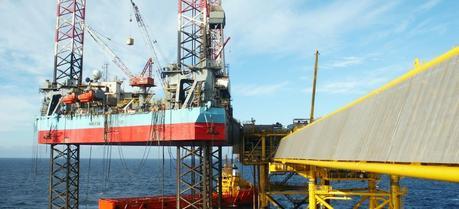 A rig somewhere off the coast of Denmark. (Credit: Flickr @ Enrico Strocchi http://www.flickr.com/photos/strocchi/)
A rig somewhere off the coast of Denmark. (Credit: Flickr @ Enrico Strocchi http://www.flickr.com/photos/strocchi/)
According to the United States Geological Survey (USGS), the Alum Shale in Denmark contains an estimated mean of 6.9 trillion cubic feet of undiscovered, technically recoverable natural gas. This estimate comes from the first-ever USGS assessment of shale gas resources in Denmark.
The geological foundation that underpins the assessment was facilitated by data provided by the Geological Survey of Denmark and Greenland. USGS released the assessment to the GSDG in a meeting earlier this morning.
“This is a potential resource for Denmark, although there is no current production there,” said USGS Acting Director Suzette Kimball. “The complicated geology in Denmark and the difficulty involved in assessing it really demonstrates how important it is to have a robust geologic model underpinning all of our assessments.”
The Alum Shale is part of the Baltic Basin and is made up of two assessment units, the onshore portion and the offshore portion. The offshore area was estimated to contain a mean of 4.4 trillion cubic feet of gas and the onshore area was estimated to contain 2.5 trillion cubic feet of gas.
Using its geology-based methodology, the USGS team estimated recoverable gas resources to range from 0 to 13.3 trillion cubic feet of natural gas in the Alum Shale. The wide range in the estimate reflects the geological uncertainty inherent in this as-yet largely untested resource. A complicated geological history of burial, uplift, and erosion may have led to the loss of the natural gas over time, which contributes to the large uncertainty.
In most areas of Denmark, the burial history of the Alum Shale resulted in temperatures consistent with the formation of oil; however, subsequent additional heating transformed the oil into natural gas. Thus shale oil is not expected from the Alum Shale.
Areas of the Alum Shale with potential for gas production are found beneath Jutland and the Island of Zealand, including the City of Copenhagen, and beneath parts of the North Sea, the Kattegat and the Baltic Sea near Bornholm.
This assessment is part of the USGS World Petroleum Project, in which the USGS is assessing conventional and unconventional formations to determine undiscovered, technically recoverable resource potential. Previously published USGS assessments of unconventional resources have included areas in Poland, India, China, and several countries in South America.
Continuous oil and gas, also sometimes referred to as unconventional, remains in or near the original source rock, and, instead of escaping the source rock and collecting in distinct accumulations like conventional oil and gas, is dispersed unevenly over large geographic areas.
Technically recoverable oil resources are those producible using currently available technology and industry practices. USGS is the only provider of publicly available estimates of undiscovered technically recoverable oil and gas resources of the world.

